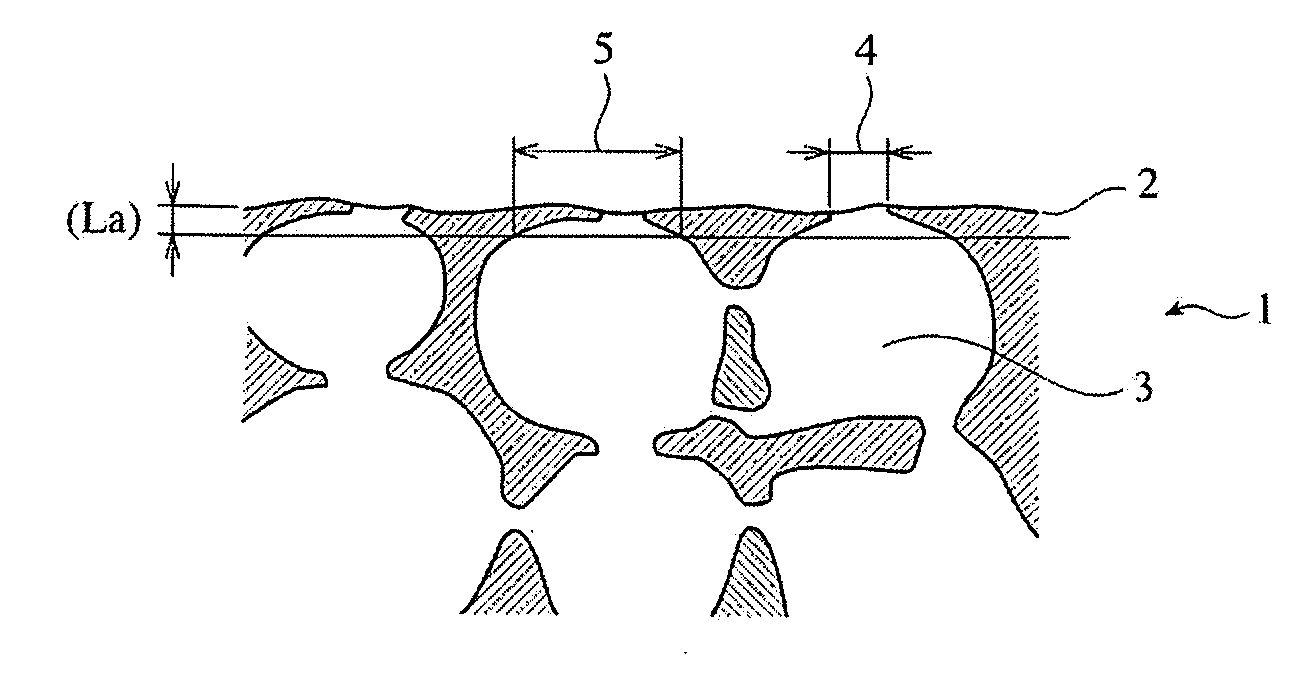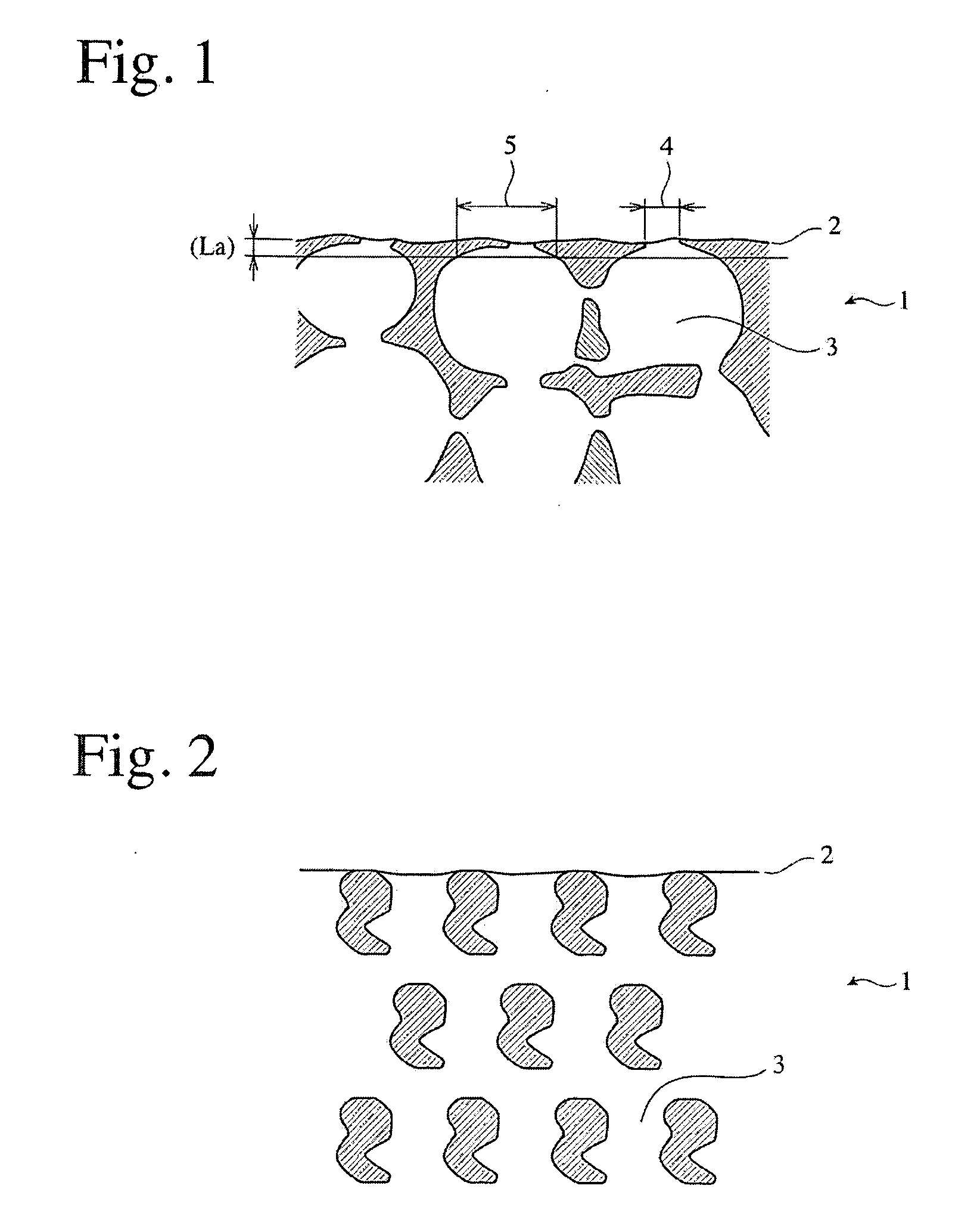Ceramic honeycomb structure and moldable material usable for its extrusion molding
a technology of ceramic honeycomb and moldable materials, which is applied in the direction of machines/engines, chemical/physical processes, domestic applications, etc., can solve the problems of poor thermal shock resistance, large pressure loss, and difficulty in achieving high capturing ratio of particulate matter and low pressure loss, and achieve low pressure loss and high particulate-matter-capturing ratio
- Summary
- Abstract
- Description
- Claims
- Application Information
AI Technical Summary
Benefits of technology
Problems solved by technology
Method used
Image
Examples
examples 1-12
[0086] Powders of kaolin, talc, alumina, aluminum hydroxide and silica, etc. each having an average particle size of 40 μm or less were mixed to obtain a cordierite-forming powder, at such mass ratios of SiO2:48-52%, Al2O3: 33-37%, MgO:12-15%, CaO:0-0.05%, Na2O: 0-0.05%, K2O:0-0.05%, TiO2: 0-1.0%, Fe2O3:0-1.0%, PbO:0-0.1%, and P2O5:0-0.2%. This cordierite-forming powder was mixed with foamed hollow resin particles having an average particle size of 65 μm and methylcellulose, and then blended with water to obtain a moldable cordierite-forming material with plasticity. This moldable material was extrusion-molded through an extrusion orifice to obtain a green body having a structure of a honeycomb, which was dried and then sintered at the highest temperature of 1400° C. for 200 hours, to obtain a ceramic honeycomb structure having an outer diameter of 267 mm, a length of 304 mm, a cell wall pitch of 1.57 mm, and a cell wall thickness of 0.32 mm. Table 1 shows the storage elastic modulu...
examples 13-16
COMPARATIVE EXAMPLES 7 AND 8
[0113] Kaolin, talc, fused silica, alumina and aluminum hydroxide each having an average particle size, a particle size distribution and an Fe2O3 content shown in Tables 2 and 3 were mixed at ratios of (SiO2—Al2O3—MgO) shown in Table 4. 100 parts by mass of the resultant cordierite-forming material was mixed with 12 parts by mass of foamed hollow resin particles, 5 parts by mass of methylcellulose, and 2 parts by mass of hydroxypropyl methylcellulose. The average particle size and particle size distribution of the material powders shown in Table 2 were measured using a laser-diffraction particle size distribution analyzer LMS-30 available from Seishin Enterprise Co., Ltd. 100 parts by mass of each cordierite-forming material was blended with water to prepare a moldable material.
[0114] This moldable material was charged into an extruder to form a honeycomb green body. After drying by a microwave drier and then by hot wind, the green body was cut at both ...
examples 17 and 18
[0121] The cordierite ceramic honeycomb structures of Examples 17 and 18 were produced in the same manner as in Examples 14 and 15, except that 10 parts by mass of foamed hollow resin particles were added as a pore-forming agent.
PUM
| Property | Measurement | Unit |
|---|---|---|
| Length | aaaaa | aaaaa |
| Fraction | aaaaa | aaaaa |
| Fraction | aaaaa | aaaaa |
Abstract
Description
Claims
Application Information
 Login to View More
Login to View More - R&D
- Intellectual Property
- Life Sciences
- Materials
- Tech Scout
- Unparalleled Data Quality
- Higher Quality Content
- 60% Fewer Hallucinations
Browse by: Latest US Patents, China's latest patents, Technical Efficacy Thesaurus, Application Domain, Technology Topic, Popular Technical Reports.
© 2025 PatSnap. All rights reserved.Legal|Privacy policy|Modern Slavery Act Transparency Statement|Sitemap|About US| Contact US: help@patsnap.com



